Injeolmi aka roasted soybean mochi is a soft and chewy Korean treat made from sweet glutinous rice. It's quick, easy and delicious!
Jump to:
I'm back with another mochi recipe! This time we are taking a Korean turn and creating injeolmi or roasted soybean mochi. A subtly sweet, soft and chewy glutinous rice cake covered in roasted soybean flour, aka konggaru (콩가루) or kinako (きなこ).
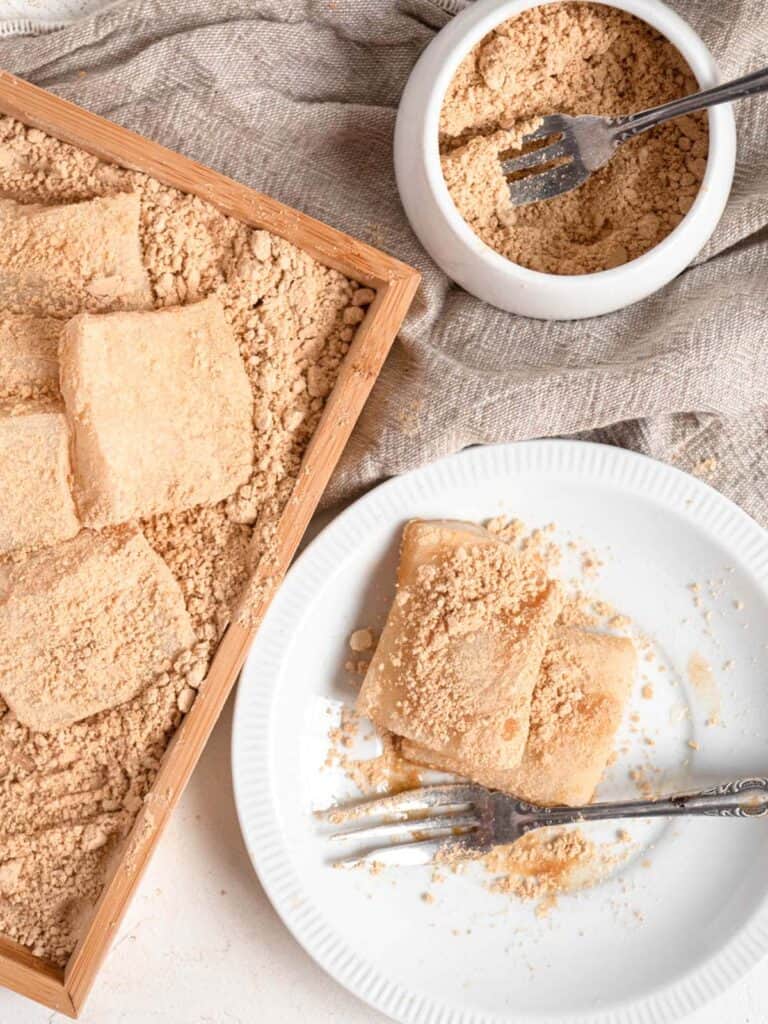
What is Injeolmi?
Injeolmi (인절미) are Korean rice cakes (aka tteok(떡) in Korean) made from glutinous rice flour and finely ground roasted soybean flour. Traditionally steamed sweet glutinous rice is pounded to create a soft and chewy rice cake, before being rolled in bean powder and cut into bite size pieces.
Unfortunately, this isn't practical when making injeolmi from home! This recipe takes you through a quick and easy way to create delicious injeolmi with sweet rice flour instead.
Although injeolmi is widely popular in Korea there are also a Japanese equivalent, kinako mochi (きなこ餅), which is pretty much the same thing!
What does injeolmi taste like?
You now might be wondering... why do I want to have roasted bean powder all over my delicious rice cake?
If you have never tried roasted soy bean powder, aka konggaru, aka kinako, you have got to give it a go. If I were to describe it, it is very similar to peanut butter, nutty, fragrant, and pairs amazingly with desserts.
Ingredients in Injeolmi
- Sweet glutinous rice flour: Also known as just glutinous rice flour, this is flour made from ground sticky rice. This ingredient creates that stretchy mochi texture. You can also use mochiko if you have that available.
- Sugar: Sugar is needed to give the dough a little sweetness, feel free to add more or less to your taste.
- Water: Water adds moisture to the rice cake dough, giving it elasticity when mixed with the glutinous rice flour
- Roasted soybean flour: Soybean flour is the delicious nutty coating that the mochi is rolled in. If you can't find it feel free to use peanut powder or finely crushed nuts.
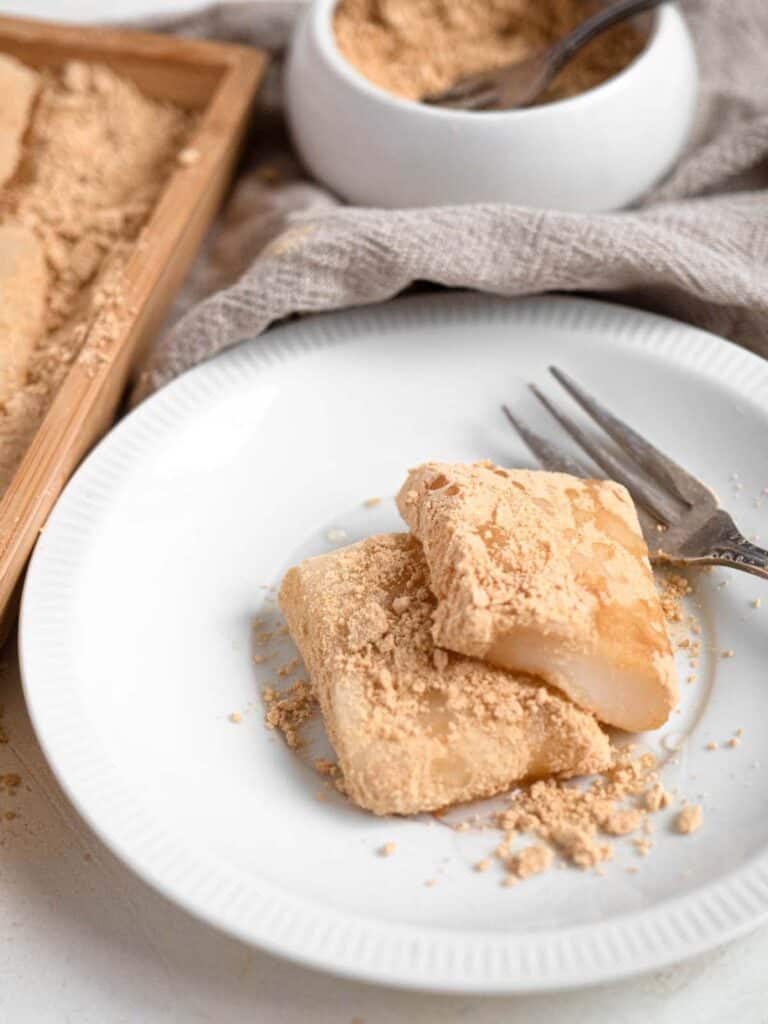
How to cook Injeolmi
The two most common ways to make mochi from home are either steaming it, or cooking it in the microwave.
Steaming
Steaming it cooks the batter evenly throughout on a slow gentle heat. The downside is it takes a lot longer.
Microwaving
Microwaving the mochi is fast and simple. All you need is 2 minutes in the microwave and it's pretty much ready to go. The downside is an uneven cook, as you will have parts slightly drier than others.
If I were to choose between the two methods I would go with microwaving. I'm all about time efficiency, and cooking something in 2 minutes is the dream. When it comes to uneven cooking there are ways around this.
The first is taking it out halfway and giving it a mix before continuing the cooking process. The other is pounding the dough. Pounding the dough helps to distribute areas that are more cooked than others resulting in a smooth and bouncy dough.
How to make stretchy mochi
This recipe is so much easier than the traditional method, but there is reason to the traditional pounding of rice. The pounding gives the rice cake elasticity and chewiness, as well as increasing its softness.
We can still use this method even when we aren't making the rice cake from scratch. I like to use a sturdy cooking utensil like a mortar and pestle, the end of a wooden rolling pin, or a wooden spoon to pound the mochi after it's cooked.
As the mochi will be very sticky I recommend greasing the utensil with some vegetable oil. This will prevent it from sticking to your utensil as you pound it.
Simply pound it for a couple of minutes until it becomes softer, stretchier, and more supple. Trust me this will change your homemade mochi game.
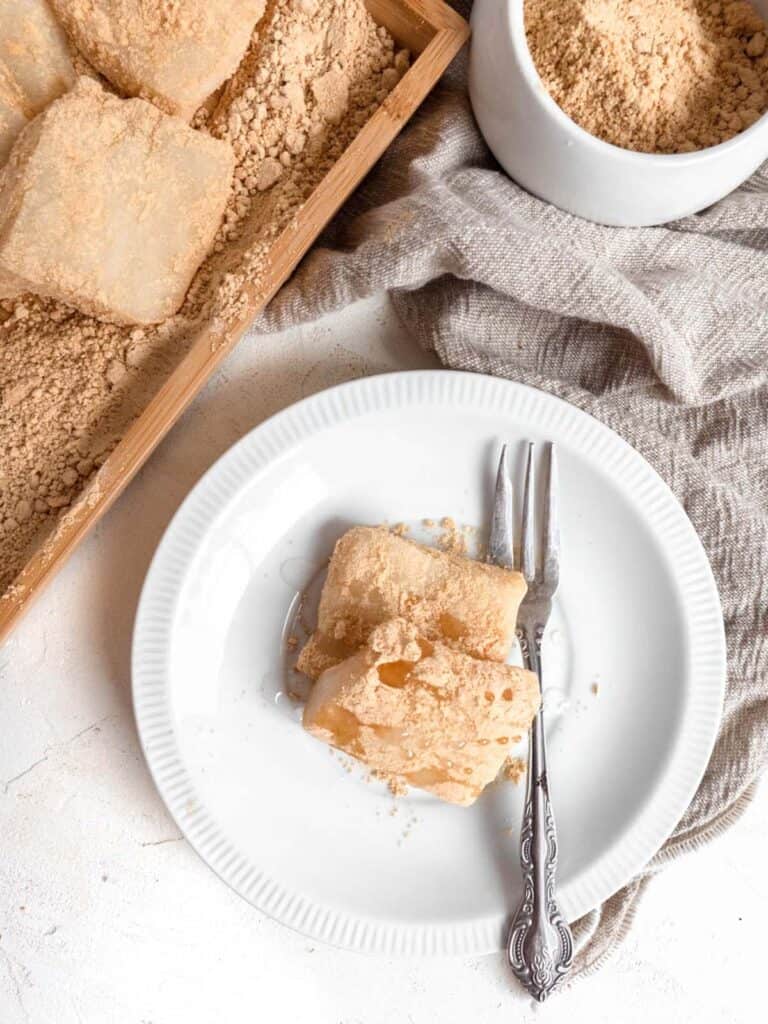
How to serve injeolmi?
There are so many different ways to serve injeolmi, here are a couple of my favorites:
- As it is: Injeolmi as it is serves as a great snack! Drizzle it in honey for a sweet touch.
- With red beans: Rice cakes and red bean paste are a match made in heaven, and if you're familiar with Asian desserts you'll know that it is one of the most common pairings.
- With bingsu: If you don't know what bingsu is, it is essentially Korean shaved ice. And in Korea injeolmi bingsu is one of the most popular flavors.
- As injeolmi toast: Another popular Korean dessert which sandwiches injeolmi between two slices of fluffy milk bread. See the section below on how to make it at home.
- As a topping on anything: Chop the injeolmi up into small pieces and scatter it over anything, from ice-cream to fruit salad there are so many options.
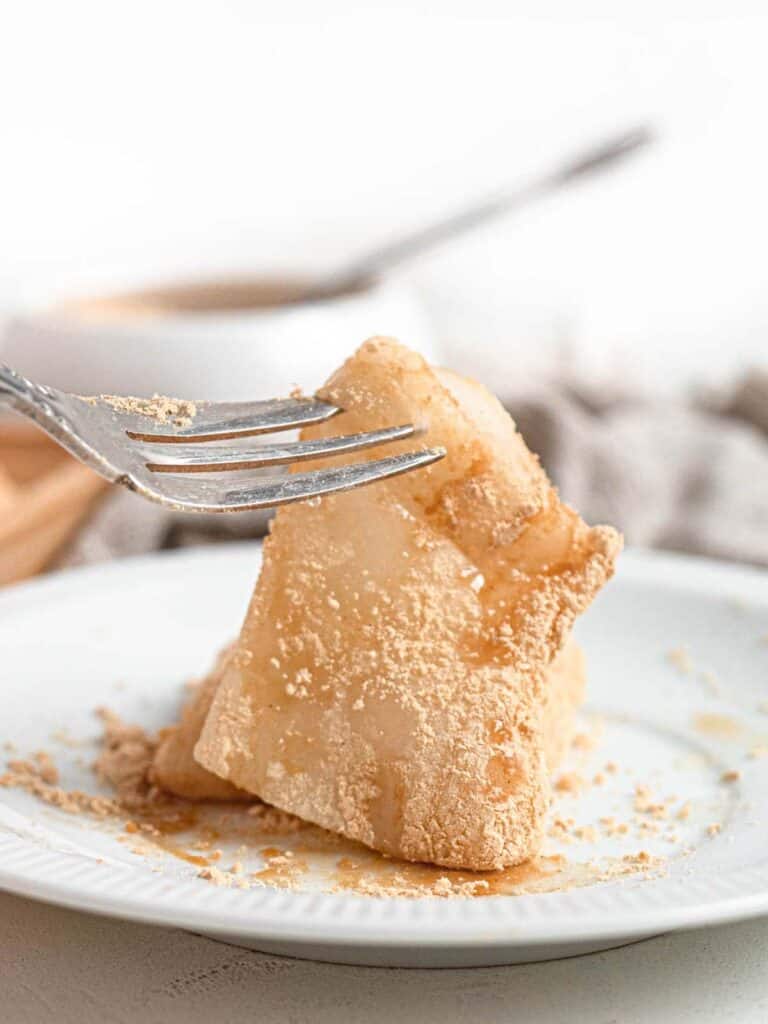
Frequently Asked Questions
How to store injeolmi?
As with most things made from glutinous rice flour they are best enjoyed on the day they are made. If you do store them keep them in an airtight container for up to three days.
How to reheat injeolmi?
If eating the injeolmi on the second or third day I recommend heating it up. This brings it back to its soft and stretchy texture.
My favorite way to reheat injeolmi is in a frying pan. All it needs is a minute on each side. Otherwise, a couple of minutes in a steamer is great too!
Heating injeolmi in the microwave can cause it to harden rather than soften. If you must heat it in the microwave I recommend placing it in a bowl with a couple of drops of water covered in cling wrap. Heat for 30-second bursts until nice and warm.
Can you freeze injeolmi?
While you can freeze injeolmi I recommend making it fresh. Defrosted injeolmi will never be as soft and supple as freshly made injeolmi.
If you freeze your injeolmi heat it up as per the "how to reheat injeolmi" instructions to return it to its soft and chewy texture.
How do you make injeolmi toast?
Injeolmi toast is a popular dessert found in many South Korean cafes.
It is essentially injeolmi drizzled in honey sandwiched between two slices of fluffy milk bread. This is then toasted with butter, sprinkled with more soybean powder, and drizzled with more honey.
The result is a sweet dessert with all your favorite textures: crunchy, chewy, and stretchy.
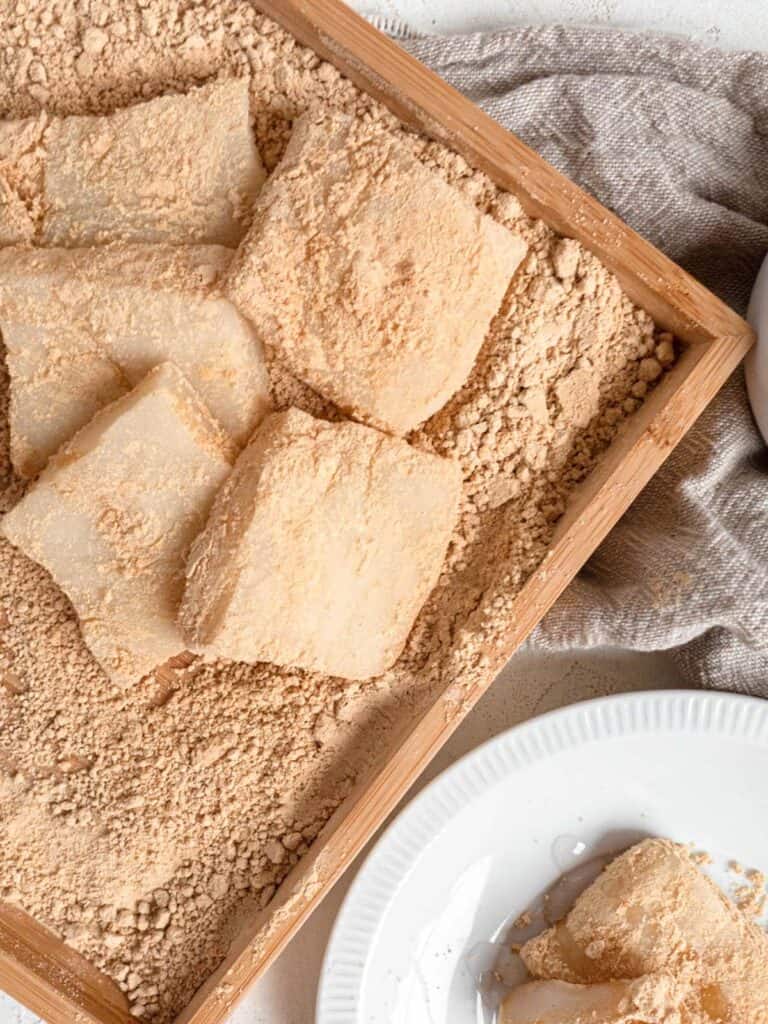
Let's Get Cooking!
Now you know all about injeolmi it's time for you to go and make your own! This soft, chewy delicious nutty treat is perfect served with a drizzle of honey and a cup of tea. It is also amazing as a topping for your ice cream, or baked into a cookie (we've got an upcoming recipe...)!
If you liked this recipe make sure to leave me a comment and rating down below, I would love to know how you went.
Also, don't forget to tag me on Instagram @catherine.desserts and hashtag #cattycakes so I can see and share your desserts. Follow me on Facebook, Pinterest, Youtube, and TikTok for more of my baking creations and updates! Until next time... happy baking!
Print📖 Recipe
Injeolmi (Roasted Soybean Mochi)
Soft and chewy mochi rolled in roasted soybean powder. Injeolmi is a delicious Korean treat made from sweet glutinous rice that you'll love.
- Prep Time: 10
- Cook Time: 2
- Total Time: 12
- Yield: 12 squares 1x
- Category: Mochi
- Method: Easy
- Cuisine: Korean
- Diet: Gluten Free
Ingredients
- 150g Sweet glutinous rice flour (1 cup)
- 25g Sugar (I) (2 tbsp)
- 155g Water (⅔ cup)
- Roasted soybean flour, to dust
- 25g Sugar (II) (2 tbsp), to dust
Instructions
- Combine glutinous rice flour, sugar (I) and water in a large microwave-safe bowl
- Cover with cling wrap and poke several holes in the cling wrap with a fork
- Place in the microwave and heat for 2 minutes on high
- Remove and mix the dough, ensuring that there are no areas that are still raw/liquid (if there is continue to heat for 30 seconds)
- Then pound the dough using a wooden spoon, until the dough is smooth, bouncy and elastic
- Sprinkle a generous layer of roasted soybean flour on a tray/plate, then dust with sugar (II)
- Transfer the dough to the tray/plate and spread it into a 1cm thick rectangle
- Flip the dough so that both sides are lightly covered in soybean powder
- Cut into small bite-sized squares and enjoy!

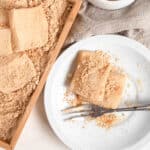
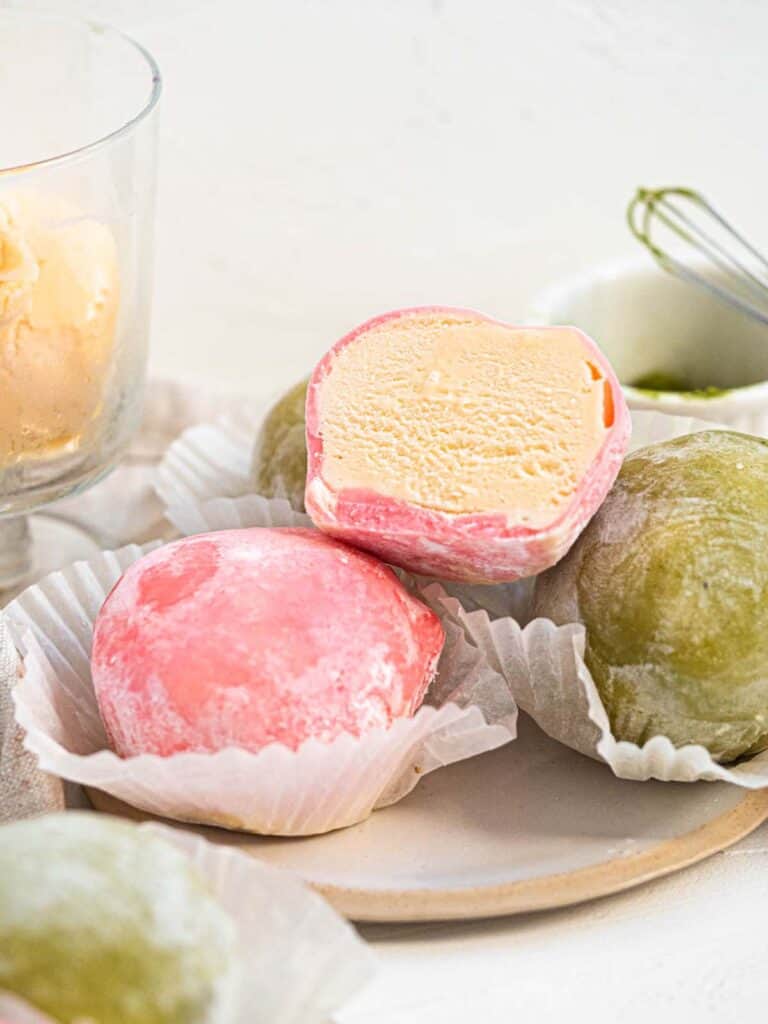


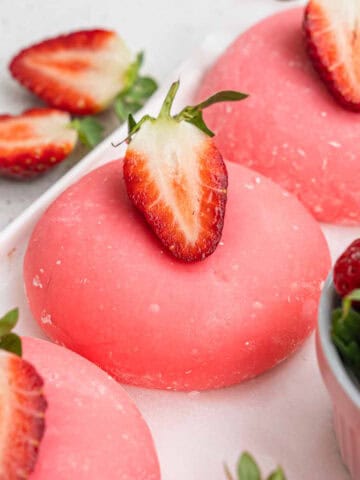
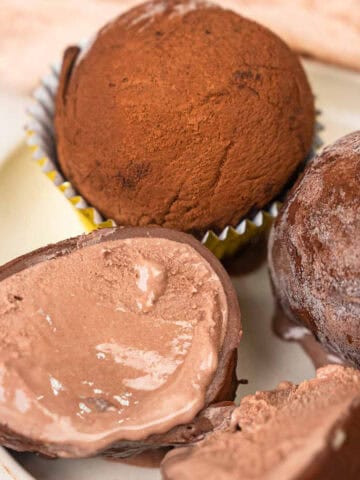
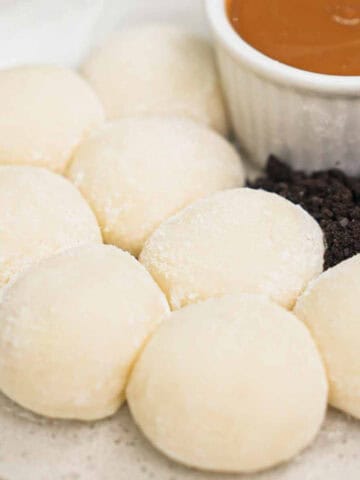
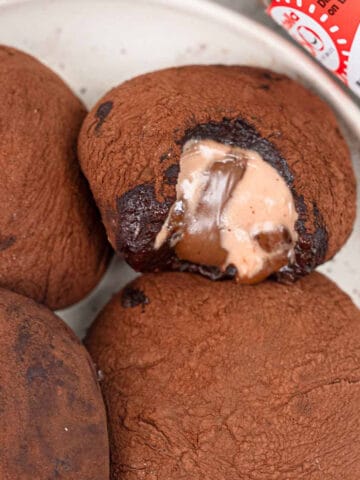
Kathleen Hsu
Thank you so much for this recipe! I will definitely try this recipe this weekend!
Catherine
Yay! Hope you like them 😍
Camille
This was so tasty! My friends loved them that we made another batch together! We ate this with vanilla ice cream with additional kinako powder. Yum! This saved us from eating out for dessert. 😛
Catherine Zhang
Ice-cream and injeolmi is the best! So glad you liked it!